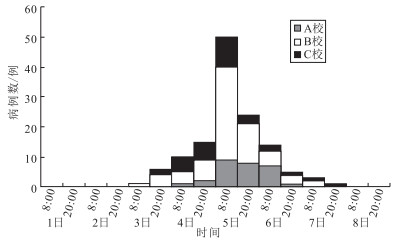An investigation of bacillary dysentery outbreaks in three schools in Ankang
-
摘要:
目的 了解安康市某3所学校细菌性痢疾暴发原因,分析疫情发生特点,积累疫情处置经验,为以后疫情防控提供科学依据。 方法 建立病例定义,选取3所学校(A、B、C)全部学生和教职员工中所有疑似病例、可能病例、确诊病例开展流行病学调查,选择对照组进行病例对照分析,采集相关样品进行实验室检测。 结果 3所学校共发病132例,均为学生,罹患率为17.74%;A幼儿园罹患率为20.00%、B中心小学罹患率为21.74%、C初级中学罹患率为11.61%。队列和病例对照研究提示学校为暴露场所,学校内生水洗手为危险因素。实验室检测9份粪便样品,8份为志贺菌阳性,阳性率为88.99%,学校管网末梢、食堂水桶水样、下水管道地漏检出志贺菌。 结论 该疫情是一起由志贺菌引起3所学校细菌性痢疾暴发疫情,可能由于3所学校生活用水开学前被粪便污染导致。建议加强农村集中供水和施工管理,各级监督部门加大监管力度,各级学校开学前做好卫生清洁和消毒工作。 Abstract:Objective To investigate risk factors and epidemiological characteristics of bacillary dysentery outbreaks in three schools, and to provide scientific basis for the prevention and control of the epidemic in the future. Methods Case definition was established. All suspected, possible and confirmed cases of all students and faculty members from 3 schools (A, B, C) were selected for epidemiological investigation. Control group was used for case-control analysis, and relevant samples were collected for laboratory testing. Results A total of 132 cases were found in 3 schools, all of which were from students, with the incidence rate of 17.74%. The morbidity in kindergarten A was 20.00%, in center primary school B it was 21.74%, and in junior middle school C it was 11.61%. Cohort studies and case-control studies suggested that schools are exposed places and that washing hands with raw water in schools was possible risk factor. Nine stool samples were tested in laboratory, among which 8 were positive for Shigella(88.99%), and Shigella was detected in the end nodes of school's pipeline network, the water samples from canteen bucket, and the floor drains of sewer pipe. Conclusion The bacillary dysentery outbreaks in 3 schools was caused by Shigella, which may be due to fecal contamination of domestic water in 3 schools before the start of the school year. It is suggested to strengthen the management of centralized water supply and construction in rural areas, intensify the supervision at all levels, and sanitation and disinfection before school opens at all levels. -
Key words:
- Shigella, dysentery /
- Disease outbreaks /
- Incidence /
- Students /
- Epidemiologic studies
-
表 1 B校细菌性痢疾暴发患者病例对照研究结果
Table 1. Case-control study results of patients with bacillary dysentery outbreaks in B school
组别 例数 生水洗手 生水洗脸 饮食 3日晚餐 4日早餐 4日午餐 4日晚餐 5日早餐 病例组 21 18(85.71) 18(85.71) 18(85.71) 20(95.24) 10(47.62) 7(33.33) 5(23.81) 对照组 21 12(57.14) 17(80.95) 15(71.43) 19(90.48) 12(57.14) 5(23.81) 6(28.57) χ2值 4.20 10.17 1.27 0.36 0.38 0.48 0.12 P值 0.04 0.68 0.26 0.55 0.54 0.50 0.73 注:()内数字为报告率/%。 -
[1] 李红军, 杨艳娜, 杜娟, 等. 某大学一起细菌性痢疾暴发疫情流行病学调查[J]. 首都公共卫生, 2019, 13(4): 199-201, 208. https://www.cnki.com.cn/Article/CJFDTOTAL-SDGW201904011.htmLI H J, YANG Y N, DU J, et al. Epidemiological investigation of an outbreak of bacterial dysentery in a university[J]. Capital J Public Health, 2019, 13(4): 199-201, 208. https://www.cnki.com.cn/Article/CJFDTOTAL-SDGW201904011.htm [2] 潘欢弘, 刘晓青, 杨富强, 等. 某中学一起细菌性痢疾暴发疫情流行病学调查[J]. 应用预防医学, 2015, 21(6): 413-414, 417. doi: 10.3969/j.issn.1673-758X.2015.06.015PAN H H, LIU X Q, YANG F Q, et al. Epidemiological investigation of an outbreak of bacterial dysentery in a middle school[J]. Appl Prev Med, 2015, 21(6): 413-414, 417. doi: 10.3969/j.issn.1673-758X.2015.06.015 [3] 经正敏, 马涛, 冯智, 等. 南京市两所高校细菌性痢疾暴发调查[J]. 中华卫生应急电子杂志, 2016, 2(6): 358-364. https://www.cnki.com.cn/Article/CJFDTOTAL-YJWS201606006.htmJING Z M, MA T, FENG Z, et al. Outbreak investigation of bacterial dysentery in two colleges in NanJing[J]. Chin J Hyg Res(Elet Edit), 2016, 2(6): 358-364. https://www.cnki.com.cn/Article/CJFDTOTAL-YJWS201606006.htm [4] 国家卫生健康委员会. 全国细菌性痢疾监测方案(试行)[A]. [2015-08-22]. http://www.nhc.gov.cn/wjw/zcjd/201304/ac06031652644d308429d8a5a36ff443.shtml.National Health Commission of the People's Republic of China. National Bacillary Dysentery Program[A]. [2015-08-22]. http://www.nhc.gov.cn/wjw/zcjd/201304/ac06031652644d308429d8a5a36ff443.shtml. [5] 李兰娟, 任红, 高志良, 等. 传染病学[M]. 9版. 北京: 人民卫生出版社, 2018: 182-187.LI L J, REN H, GAO Z L, et al. Infectious Diseases[M]. 9nd Edition BeiJing: People's Medical Publishing House, 2018: 182-187. [6] 龙术国, 熊新平, 杨健, 等. 醴陵市某学校一起菌痢暴发调查[J]. 实用预防医学, 2016, 23(8): 975-977. doi: 10.3969/j.issn.1006-3110.2016.08.024LONG S G, XIONG X P, YANG J, et al. Outbreak investigation of bacterial dysentery in school in Li Ling[J]. Pract Prevent Med, 2016, 23(8): 975-977. doi: 10.3969/j.issn.1006-3110.2016.08.024 [7] 常昭瑞, 张静, 张伟东, 等. 2008-2011年我国细菌性痢疾暴发疫情分析[J]. 中国食品卫生杂志, 2012, 24(6): 554-558. https://www.cnki.com.cn/Article/CJFDTOTAL-ZSPZ201206013.htmCHANG Z R, ZHANG J, ZHANG W D, et al. Analysis on bacillary dysentery outbreaks in China, 2008-2011[J]. Chin J Food Hyg, 2012, 24(6): 554-558. https://www.cnki.com.cn/Article/CJFDTOTAL-ZSPZ201206013.htm [8] 黄兆勇. 食源性疾病的流行和监测现状[J]. 应用预防医学, 2012, 18(2): 125-128. https://www.cnki.com.cn/Article/CJFDTOTAL-GXYX201202024.htmHUANG Z Y. Foodborne diseases of epidemic and monitoring situation[J]. J Appl Prevent Med, 2012, 18(2): 125-128. https://www.cnki.com.cn/Article/CJFDTOTAL-GXYX201202024.htm [9] 孟昭伟, 雷佩玉, 郑晶利, 等. 2015年陕西省农村饮水工程水质监测结果分析[J]. 实用预防医学, 2018, 25(11): 1321-1324. doi: 10.3969/j.issn.1006-3110.2018.11.010MENG Z W, LEI P Y, ZHENG J L, et al. Monitoring results of water quality in rural drinking water safety projects in Shaanxi Province, 2015[J]. Pract Prev Med, 2018, 25(11): 1321-1324. doi: 10.3969/j.issn.1006-3110.2018.11.010 -







 下载:
下载:

